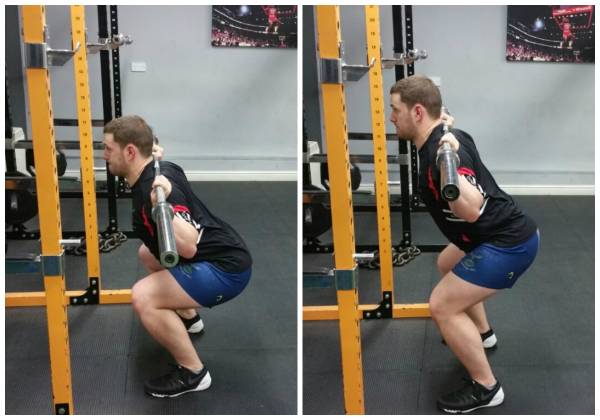Squats. Sitting down with a weight on your back then standing back up. They sound simple, but unfortunately they aren’t. Technique plays a significant role in your ability to move heavy loads. One of the biggest technique mistakes I see destroying what could be a great squat is where you place your hands. Watch the video below to see what I mean.
Two Components of a Good Squat
Stability and tension are two key components to an efficient squat. The ability to brace your body from your little toe to your head is a must. When you lose tension in your upper body (your lats, traps, trunk, and lower back), you transition into an awful good-morning-type-squat, where the weight falls forward and your hips rise. You end up squatting just using your back muscles, or even stuck at the bottom of the squat.
A common cause of this loss of tension and subsequent dangerous position is your hand-width placement on the bar. I see an increasing number of people squatting with a super-wide hand position, their hands almost touching the weight plates. If you have shoulder issues, this may be the only way to squat. However, if you can get narrower in your grip, you should continue reading.
A grip that is too wide (left) is one of the most common squatting mistakes I see.
Why Your Hands Matter
When you place your hands at the extremities of the bar, you lose the ability to significantly engage your lats, drive your elbows forward, and keep your chest standing proud. With this lack of back engagement, the sheer weight of the bar pushes your chest forward and away from your center of mass.

A wide grip forces your chest forward and prevents lat activation.
Once you sink to the base of your squat, success becomes a question of how strong your lower back is, as it is obliged to bear the brunt of a heavy good morning. The bar has moved further away from your center of mass, so the hips rise to try and stop the weight from pulling you forward. You end up with back pain rather than leg and glute activation.

Instead of glute activation, you get what resembles a heavy good morning.
A Simple Solution
There is a simple fix for this poor squatting. Just bring the hands closer in to your body. Whether you can do this will be dependent on your shoulder mobility and flexibility. If you are unable to bring your hands closer together, you should be working on correcting your mobility anyway.

A narrower position allows you to drive your chest upwards, so your lower back no longer bears the brunt of the lift.
A narrower hand position creates far more tension. This is because you can pull your elbows in towards your hips and push them further forward, which drives the chest upwards and maintains good form. This position will then allow your hips to come through at the right time, help drive your back upwards, and keep your chest nice and proud. Notice how the bar now sits over the center of mass and makes the weight feel lighter, too.
Congratulations, you are now squatting using your legs instead of just your lower back. Enjoy your increase in load and decrease in pain.
Another great article on squatting:






